What’s a better way to welcome spring than with the burst of cheery yellow flowers? Yes, we are talking about forsythia. This shrubby perennial can provide a joyful-looking backdrop, centerpiece, or border for your yard. Also, you can treat it as a fast-growing flowering hedge, making it a nice addition to your garden all-year-round. Explore now the most interesting forsythia varieties and learn how to grow them.
A yellow flowering shrub, forsythia is known for its long branches that provide a sunny sight in early spring. It bursts into a lively display of golden blooms before any leaves appear.
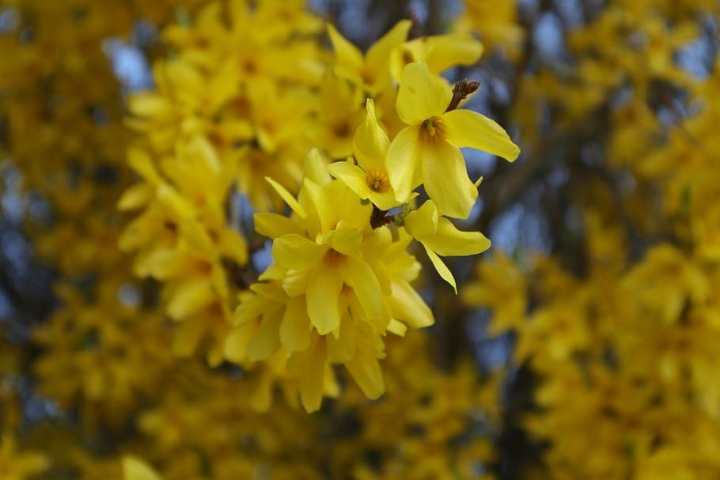
However, if you’re considering growing a forsythia, you need to take proper care of it. Planting it properly is also important. Otherwise, the plant may not fully develop. So, let’s get started!
The Meaning of Forsythia
Forsythia symbolizes spring sun and anticipation. No surprise there since it flowers in spring.
Other meanings of the plant are dignity and nobility. The Victorians used it to express their positive feelings for someone they held in high esteem.
This may not be the most gifed flower these days, but it can surely add color to your garden.
Forsythia Facts
Here are a few key facts about this flower, which has been around in gardens around the world for quite some time now.
- This plant was named after William Forsyth, a Scottish horticulturist of the 18th century.
- The flowers usually grow in a wide range of yellows, from pale to deep yellow. The length of these flowers can vary from 1 ¼ to 1 ½ inches. They are bell-like and grow in clusters.
- In traditional Chinese medicine, this flower has been used for detoxifying the body and treating fever and cold.
- During rain, forsythia flowers tip downward to protect their pollen. This plant sure knows how to keep the bees happy!
- The flowers are shade-tolerant, deer-resistant, and can survive drought.
- This plant is related to the olive tree, though that doesn’t make it edible!
Popular Forsythia Varieties
When it comes to the color of the different forsythia types, there isn’t much variety. Yellow, yellow, and yellow. There is just one exception: the white forsythia.
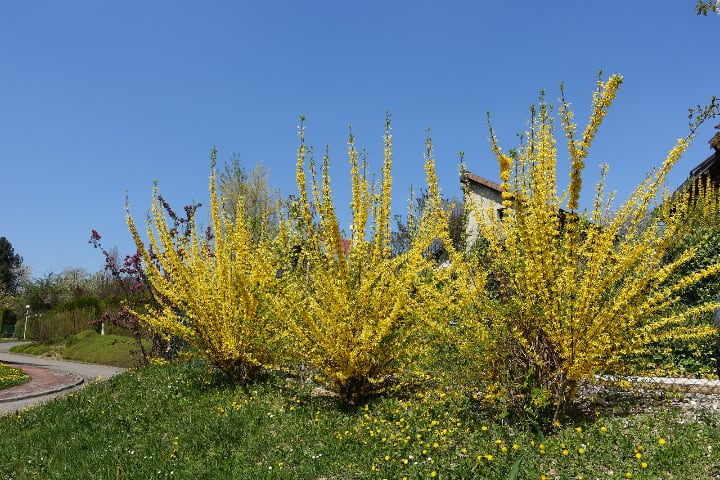
This doesn’t mean different varieties are not interesting, though. Far from it. They differ in size, shape, and bloom times.
Let’s take a closer look at the most common forsythia varieties with their characteristics.
1. Forsythia Suspensa
Forsythia Suspensa, also known as the weeping forsythia, is a common variety of the plant native to Asia. Known for their pale yellow flowers and large size, these shrubs are reliable and tough.
The flowers are usually 8 to 10 feet in height, with leaves of about 2-5 inches in length.
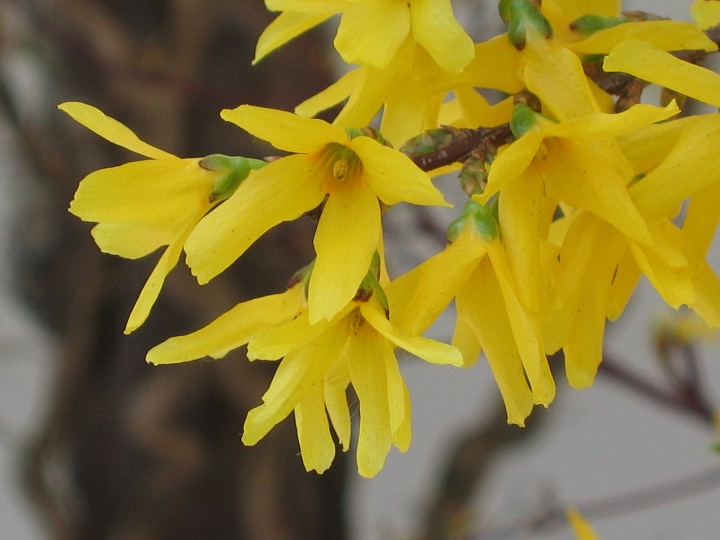
You’re looking at a great hedging plant. Be it on a slope or hanging over a wall, forsythia flowers look beautiful either way. This variety blooms from April to May and has a 4-petal bloom.
Did you know: This flower is a fundamental herb used for making traditional as well as drug-based medicines for treating fever, sore throat, swelling, or vomiting.
2. Northern Gold Forsythia
This beautiful golden-yellow flower bears the title of the “official harbinger of spring”. The upright-growing Northern Gold blooms early in the spring season before the dark green leaves appear.
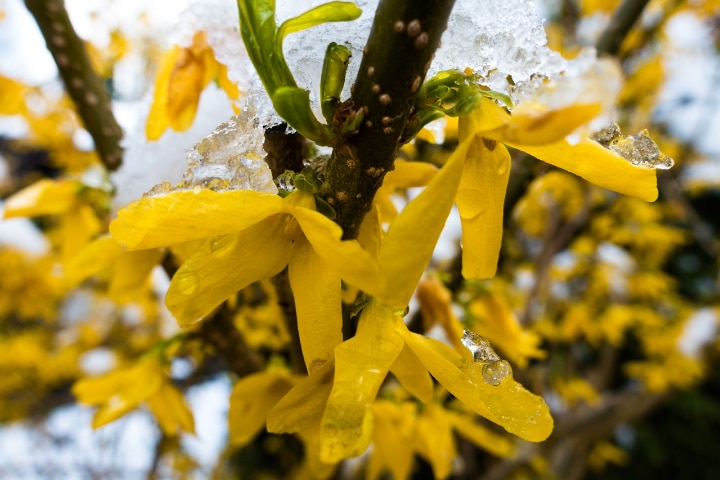
Growing to a height of 6-8 feet and a width of 5-7 feet, this plant thrives in full sun and moist soil.
Tip: This variety is great for creating a striking yellow landscape.
3. Border Forsythia
The Border Forsythia, also known as “golden bells”, is a medium-sized plant easily recognized in the south. It’s famous for producing vibrant bright yellow flowers.
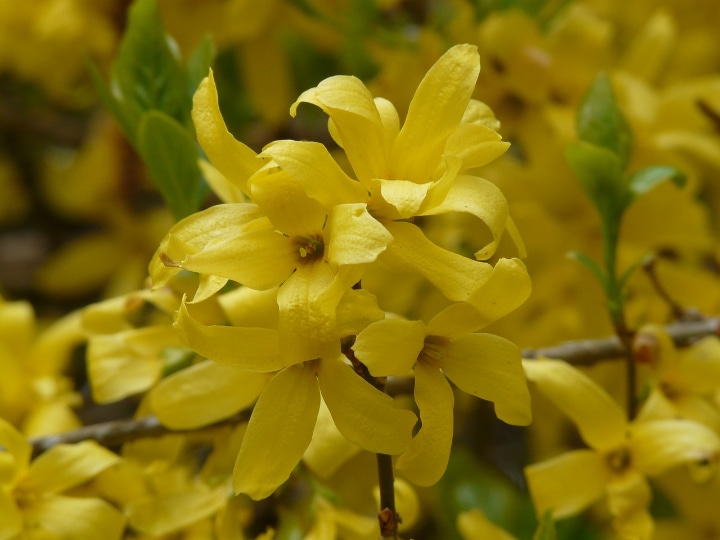
You’re looking at a hybrid between the Green-Stemmed Forsythia and the Weeping Forsythia that can grow in both full sunlight or partial shade.
Another great thing about this species is that it is quite noticeable even in twilight because of its eye-catching yellows.
4. Vermont Sun Forsythia
One of the hardiest varieties around, this one is also known as Forsythia Mandschurica.
The leaves are round in shape and 3 inches in diameter. If you look at the image below, you can notice the stiff and upright branches, a key feature of this variety.
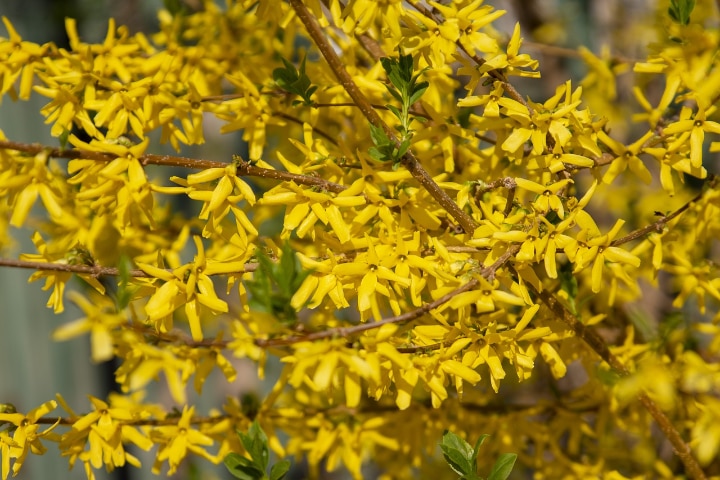
The sulfur yellow flowers emerge from black buds. The flowers are hardy and deciduous. Blooming starts in early February.
Good to know: This Forsythia variety can grow in partial shade or full sun and reaches up to 6-8 feet in height.
5. Green Stem Forsythia
This variety is also known as Forsythia Viridissima. A compact deciduous shrub, it can grow to a height of 0.75 to 1 feet and spread to about 2 to 3 feet. The leaves have an elliptic-oblong shape and can grow up to 6 inches long.
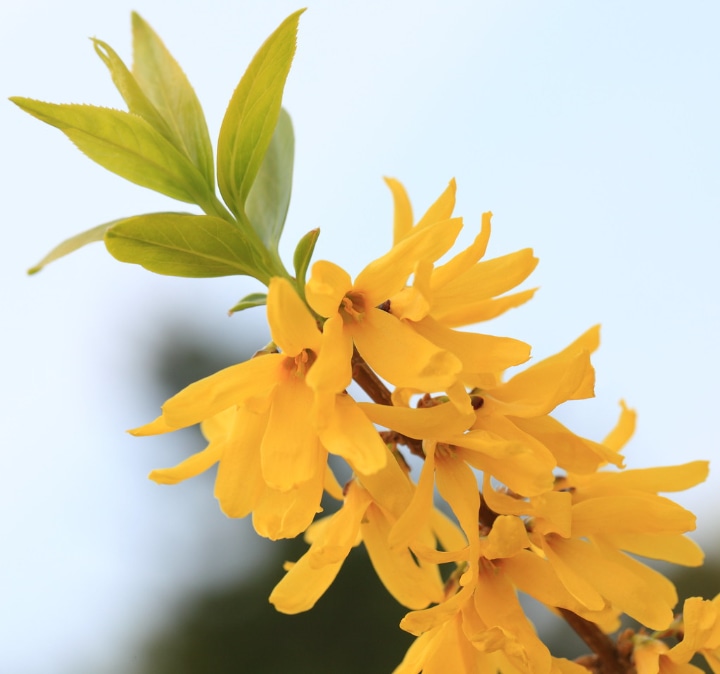
This plant boasts a low-growing habitat, blooming from March to April. It produces toned-down yellow-colored flowers and can grow in partial shade as well as under the full sun.
Tip: If you choose to grow this variety, ensure the soil is well-drained. Average to medium moisture works best.
6. Goldilocks Forsythia
Also called Courtacour or Gold Curl Forsythia, this variety is a deciduous shrub and a mutation of the Spring Glory variety.
As you can see in the image below, the flowers are solid and compact in shape and grow in abundance.
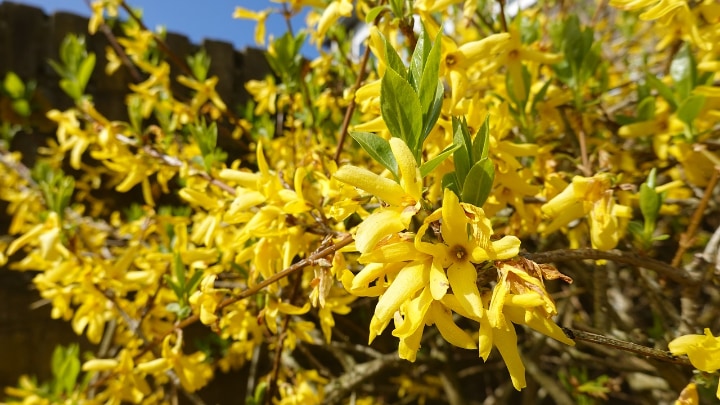
The best soil for these plants is well-drained. In terms of temperatures, don’t worry all that much. This type can survive low temperatures as well.
7. White Forsythia
White forsythia is different from all the other varieties because of its color. It produces rich white flowers, similar in shape and arrangement to those of the common yellow varieties.
This flower can sure add a touch of elegance to a garden, whether on its own or in combination with other flowering plants.
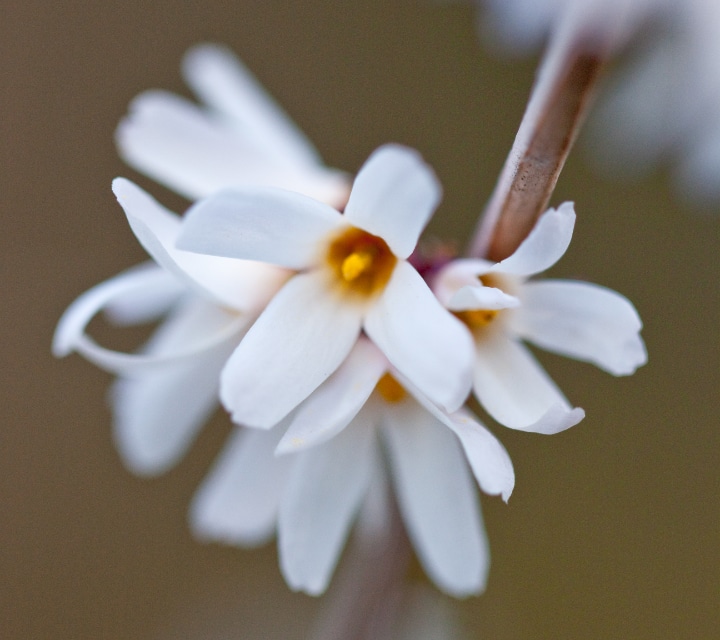
These flowers also belong to the Oleaceae family and grow to a usual height of 3 to 6 ½ feet. The blooming season is from March to April.
However, the best time to plant these shrubs is the spring or at the beginning of fall. Although it can grow both in full sunlight or partially shaded locations, it blooms best in partial sunlight.
Did you know: This plant has medicinal properties similar to those of the Witch Hazel plant, helping to treat fever and swelling, among others.
8. Gold Tide Forsythia
Also called Forsythia Courtasol, this one is a compact perennial border shrub that grows up to 24 inches and spreads about 3-4 feet across.
It’s a perfect ground cover type forsythia with some of its branches laying right on the ground.
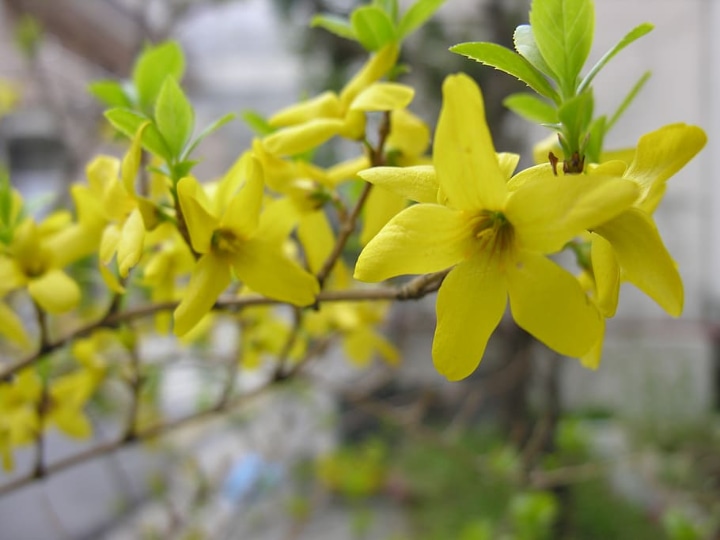
At the onset of the fall season, the flowers take up a gorgeous purplish shade on the outside and turn a pale yellow on the inside.
In the early spring season, this plant burst into amazing lemon-yellow flowers like in the image above.
9. Arnold Dwarf Forsythia
Known as a remarkable dwarf undercover type of shrub, the Arnold dwarf plant can actually reach up to 2-3 feet in high.
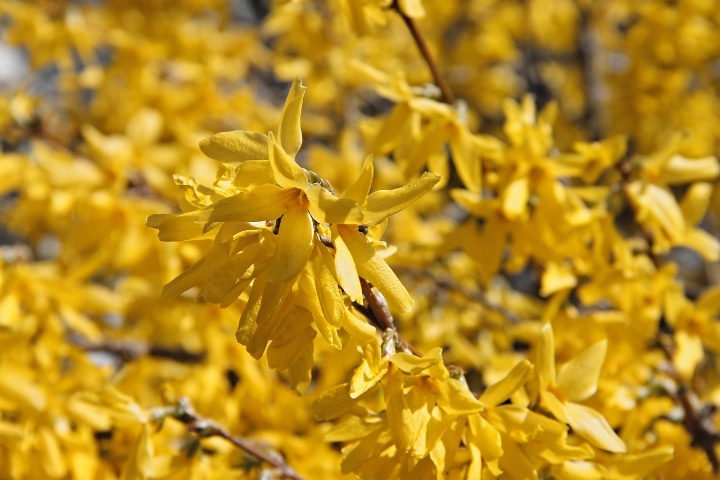
It has pale yellow flowers along with crisp green leaves. In addition, it produces lovely dark green foliage, which is transformed into a striking bronze-green color during the fall season as you can see above.
Tip: It grows well in wet, acidic, dry clay and sandy soils and in full to partial sunlight.
10. Lynwood Gold Forsythia
Last but not least, this variety looks beautiful in spring as it puts on a rich show of bright golden blossoms at a height of up to 10 feet.
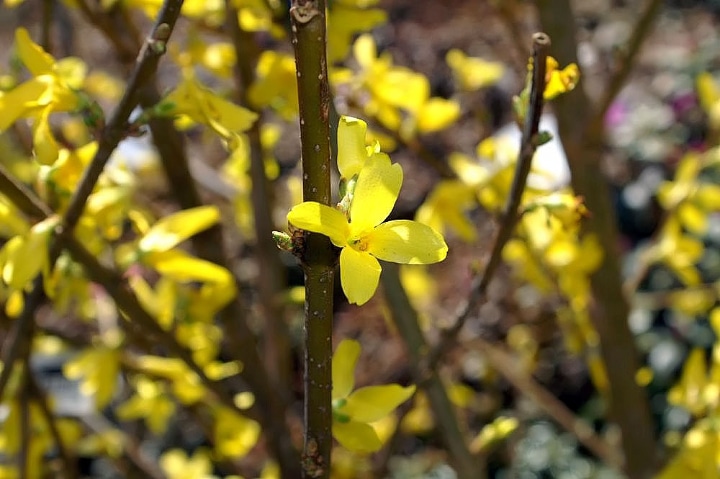
It needs well-grown soil to do well. Other than that, though, it’s not a heavy-maintenance plant.
The one fact worth mentioning about it is that as the blooms fade, the flowers take on hues of red and orange that look wonderful against the dark green leaves.
How to Grow Forsythia and Care for It
With most plants, you’re used to seeing the leaves first and the flowers later on, right? This one’s different.
The flowers of forsythia plants appear before the leaves. So, you can get an unblocked view of these gorgeous flowers.
The plant can bloom as early as late January, if you live in a warm climate, but most often, it puts on a nice yellow (or white) show in March.
Fact: The flowers tend to turn slightly yellow, purple, or maroon, depending on the amount of sunlight the plant has received.
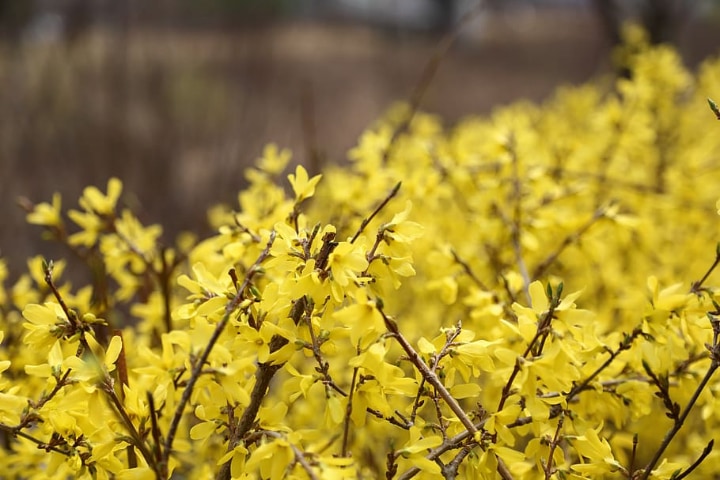
Unless killed by the cold, these flowers can last for about two to three weeks. Careful with the pruning though, as that may easily ruin them! We’ll discuss pruning in a bit.
Growing Forsythia from Seeds
A fairly easy way to grow this plant is from seeds. If you don’t have it in a pot ready for transplanting, you can just get the seeds. It’s what many gardeners do.
Look for good quality seeds and a variety that’s adapted to your region. You can find seeds locally as well as online.
Here are our recommendations to get you started:
When to Plant Forsythia
You can plant the seeds anytime there is no freeze or frost. But it’s best to avoid planting them in hot summers.
Tip: The best time to plant your forsythia is early spring.
If you miss on planting it in spring, you can also plant it in the fall. But bear in mind that a harsh winter may damage it.
Soil
Forsythia is very tolerant of almost all soil conditions. However, it grows best in clay and loam soils. Not sure about your soil? Read more about soil types.
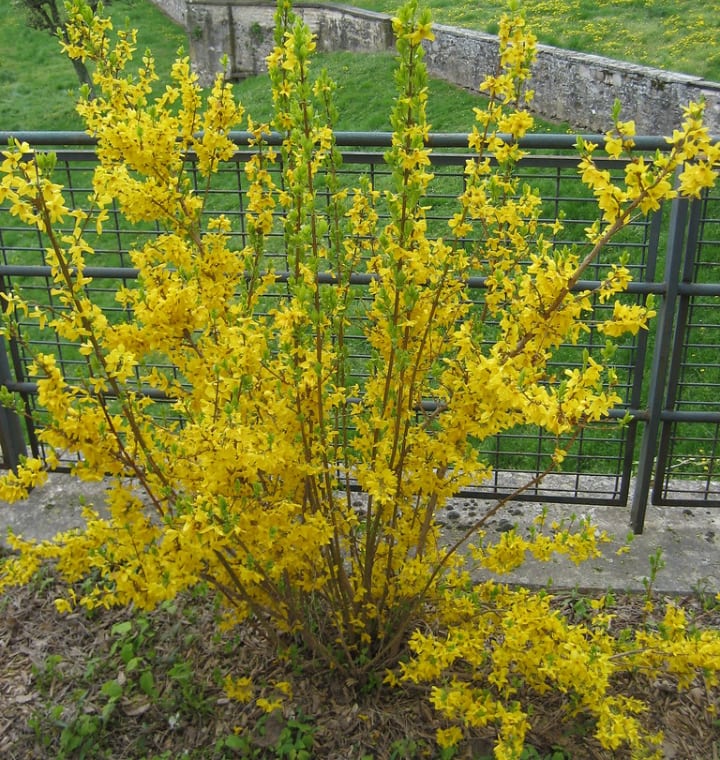
The perfect conditions for it to bloom are a well-drained garden and a medium nutrient content in the soil. The ideal pH level for these yellow flowering shrubs is 6.8 to 7.7.
If the pH of the soil is higher, you can use sublimed sulfur to lower it. If the pH needs to be raised because it’s lower than the recommended value, you can use powdered limestone.
Light
Forsythia flowers grow best in full sun and while they can also do okay in partial shade, they may not bloom as beautifully. Less sunlight than that may lead to straggly growth.
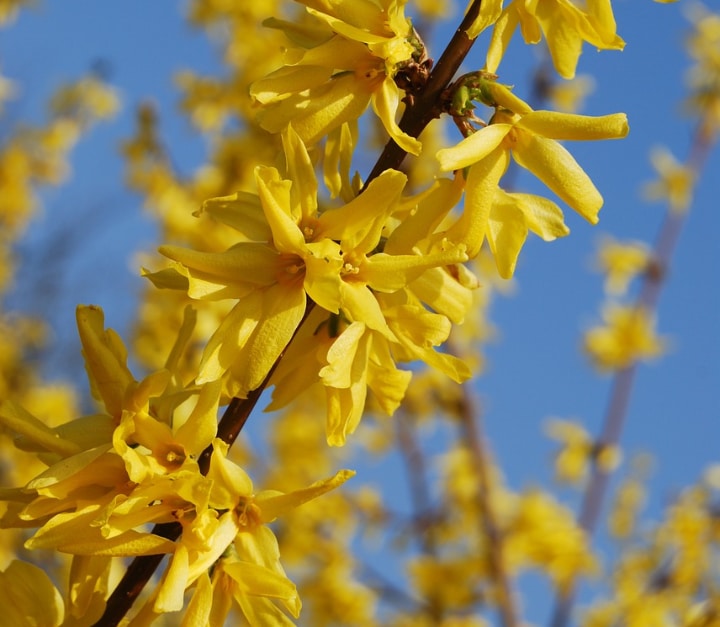
So, make sure to always place your forsythia plant in an area that gets at least six hours of direct sunlight. Anything less than that, and you’re taking chances.
Temperature
The perfect temperature to grow forsythia is between 55 to 70 degrees. The plants will be quite hardy in colder temperatures.
Keep in mind that forsythia grows well in humid climates. If the climate is too moist, the flowers will wilt, and in very dry conditions, they may not grow at all.
Watering
Often, you can water the plant only during long dry periods. But just to be sure, check the surface of the soil. Dry soil means your plant needs water–doesn’t take a genius to figure that out!
Also, pay attention to the leaves. If they sag down, it’s a sign that the plant doesn’t have enough water.
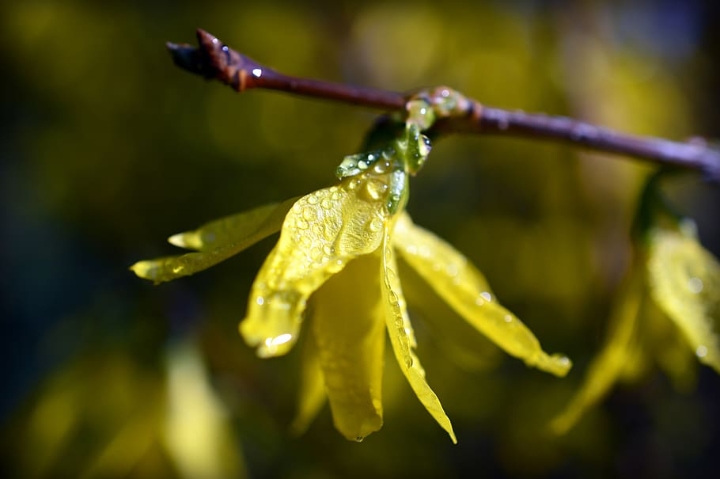
The best time to water your plant is in the early morning or evening. In the fall, winter, and spring, the plant normally doesn’t require additional watering (unless it’s an unusually dry season).
Tip: Because of the shallow roots, you have to pour the water slowly. This allows the plant to suck up the water from the upper soil before it can drain into the deeper layers.
Pruning
Pruning plays an essential role in the healthy and beautiful growth of this shrub. If you don’t prune the bushes regularly, they can grow up irregular and frankly, quite wild-looking.
And that’s probably not what you’re aiming for, right? For a neat, compact look, you want to trim your forsythia from time to time.
If your flower is not blooming, it could be because of bad pruning. Since this plant produces buds on the previous year’s growth, it’s important to prune it right after blooming.
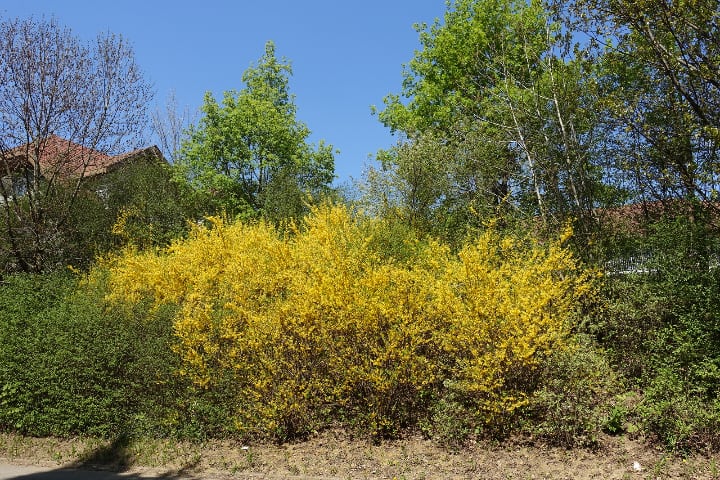
Tip: Before pruning, start by trimming 1/4 to 1/3 of the oldest branches. These must be cut right down to the ground. Along with encouraging new growth, this approach will make the shrub take a compact form.
You can also cut newer branches to give the shrub a nice and cleaner shape.
But keep in mind that you don’t have to prune this shrub every year. Some gardeners like the messy look of the shrub, which can look good in a rock garden, for example.
If you like the messy look, prune every two years or so. The bottom line is that pruning is good but not mandatory.
Wintering
While this shrub loves the sun, it usually doesn’t have much of a problem surviving winter. Older shrubs, as well as those planted in the spring, can endure low temperatures without any problem.
The only exception is if you plant it in the fall. If you do that and you then get a harsh winter, your plant may struggle to grow and, in some cases, die.
Tip: If you live in a cold climate, best wait for spring to plant forsythia to make sure it will survive winter without any problems.
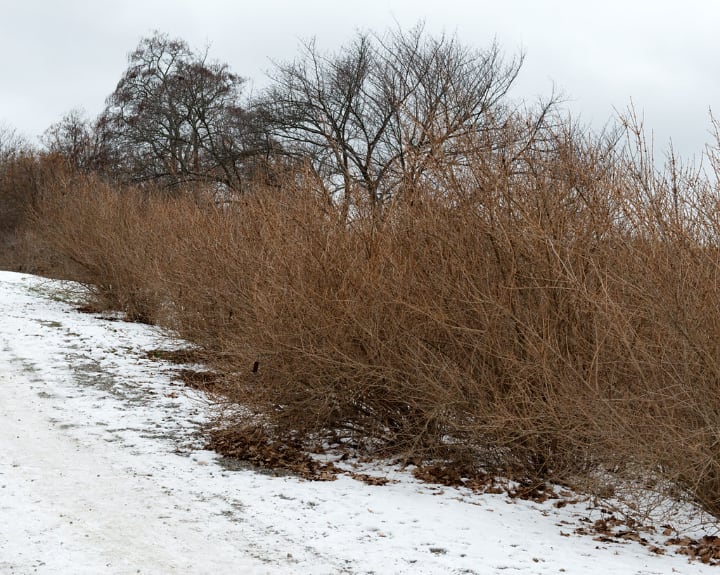
There are also two things you can do to protect your plant in winter:
- Add to it a good layer of brushwood or mulch.
- For potted plants: place them on a styrofoam plate and protect the container with a fleece or foil.
Forsythia Plant Commonly Asked Questions
We hear quite a few questions about this plant from gardeners. We thought to put together some of the most common questions and answer them here. We hope you find the answers useful!
Where does forsythia grow best?
Forsythia shrubs grow best in full sun and clay or loamy soil. Place these flowers outside or in an area that gets at least six hours of direct sunlight every day. If you do that, this versatile, adaptable, and easy-growing plant can grow 2 to 4 feet every year.
How big does forsythia get?
Forsythia is a fast-growing shrub that can grow 8 to 10 feet tall provided it has enough sunlight and good soil conditions. Here are some tips on how to grow forsythias.
What is the flowering time of forsythia?
Most forsythia varieties bloom early at the end of winter and during the beginning of the spring, providing a sunny sight before the rest of the landscape greens up.
Is forsythia easy to grow?
Yes, forsythia flowers are easy to grow and require little to no care. They just need good sunlight and moist soil to survive. Also, make sure you don’t overwater them!
Yellow Up Your Garden with Forsythia
Or white it up with the elegant white forsythia? Your call, really.
Either way, you’re looking at a beautiful, low-maintenance shrub whose stunning golden blooms can add color and volume to your garden and fill empty spaces or cover unappealing spots.
Something about the yellow blooms reaching up for the blue sky like in the image below that makes you want to have this plant in your garden, right?
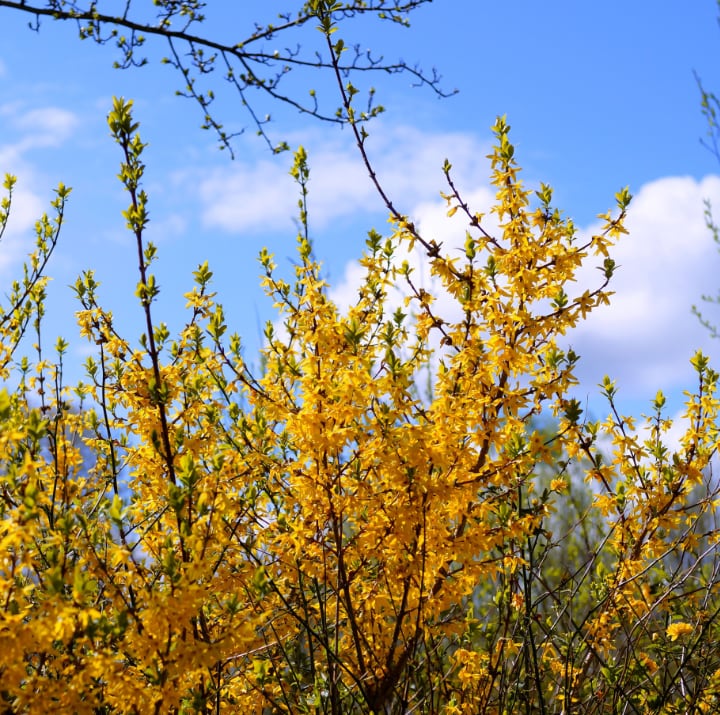
Whichever variety you choose, we recommend annual pruning to keep it neat and healthy.
Now over to you. Got any questions about these gorgeous flowers? Get in touch with us and we will be happy to answer them and help you grow lovely forsythias!

Leave a Reply